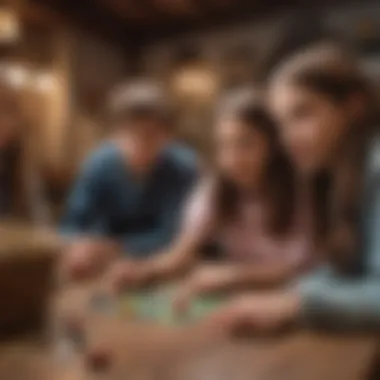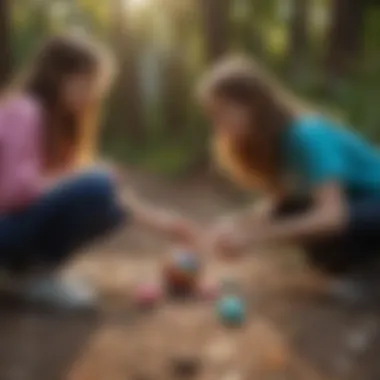Ultimate Guide to Outdoor Easter Scavenger Hunts for Tweens


Intro
When planning an Easter scavenger hunt for tweens, one must consider the unique dynamics of this age group. Tweens are at a crossroads between childhood and adolescence. They crave independence but also enjoy engaging in strategic play. A well-organized scavenger hunt not only fuels their excitement but also fosters essential social skills. The outdoor environment provides an ideal backdrop for exploration and fun.
In this guide, we will cover the various elements needed to create an unforgettable scavenger hunt experience. From effective planning strategies and selecting the right themes to crafting intriguing clues, each component plays a vital role. Moreover, safety considerations will be addressed to ensure a worry-free event. Many adults find it challenging to engage tweens, but with the right approach, you can create an enriching experience that enhances their problem-solving skills and encourages teamwork.
Prepare to dive into the nitty-gritty of designing a scavenger hunt that tweens will remember for years!
Wellness
Physical Health
Ensuring physical health is crucial in outdoor activities. Tweens are typically bursting with energy, making a physical component in your scavenger hunt essential. Incorporate tasks that require movement, such as finding hidden items that are some distance apart. This not just enhances their physical activity for the day but contributes positively to overall well-being.
Mental Health
A scavenger hunt can also be beneficial for mental health. Engaging in collaborative tasks helps with cognitive processing and encourages teamwork. Encourage tweens to communicate and devise strategies, allowing social interaction to flourish in a positive atmosphere. Letting them solve clues promotes critical thinking, which is vital at this developmental stage.
Nutrition and Diet
While planning, consider integrating snacks into the hunt. Healthy treats, like fruit or granola bars, can provide necessary energy without the crash of sugary snacks. Keep hydration in mind. Provide water stations or encourage them to bring along water bottles. This simple act can enhance focus and mood during the activities.
Fitness and Exercise
Plan activities that incorporate fitness, such as relay races or challenges that require running. Make it fun; for instance, assign points to various tasks according to difficulty. This setup naturally encourages a sense of friendly competition while establishing a focus on fitness.
"Wellness is not just about physical activity; it encompasses mental and nutrition aspects that should not be overlooked during such events."
Engaging Themes
Themes can take your scavenger hunt to the next level. Consider interests that resonate with tweens. Options include a nature hunt, sports-themed clues, or even a mystery detective-themed hunt where participants solve a series of challenges. These themes provide context and enhance the enjoyment of the hunt.
Crafting Clues
Creating clues that are age-appropriate yet challenging is key. Use riddles, puzzles, or even references to popular shows or books that your audience enjoys. Make sure to distribute them wisely during the hunt so that no one feels overwhelmed by too many tasks at once.
Tips for Safety
As crucial as the planning of activities is, safety must be prioritized. Keep an eye on the boundaries of where the hunt will take place. Set clear rules about where they can go and ensure that there are enough adult supervisors to monitor the fun.
With these initial considerations under your belt, you’re well on your way to organizing an effective and enjoyable Easter scavenger hunt for tweens. Each detail contributes to an experience that promises joy, learning, and lasting memories.
Preface to Easter Scavenger Hunts for Tweens
Easter scavenger hunts can offer a rewarding blend of skill development and fun for tweens. This age group is generally characterized by a desire for independence and increased social interaction. Choosing an outdoor scavenger hunt provides not only a way for them to engage with their peers but also encourages exploration and appreciation of nature. Moreover, such an activity promotes problem-solving skills and teamwork, which are crucial as they transition into adolescence.
When planning an Easter scavenger hunt for tweens, it's essential to understand their interests and capabilities. Tweens are at a unique developmental stage where they possess enough skills to tackle complex challenges yet still enjoy playful activities. By structuring the scavenger hunt appropriately, parents can create an environment that balances independence and guidance, allowing tweens to thrive.
The outdoors plays a pivotal role in making this experience memorable. Nature not only provides a dynamic backdrop for the hunt but also presents natural challenges and discoveries that enrich the experience. By utilizing natural surroundings, the scavenger hunt promotes physical activity, critical thinking, and social bonding among participants.
"Engaging tweens in outdoor activities fosters a connection to nature that is often lost in urban settings."
Therefore, creating an Easter scavenger hunt tailored to this age group not only entertains; it is a conduit for learning and development. In the following sections, we will explore strategies for planning a successful scavenger hunt that meets the unique needs of tweens.
Planning the Scavenger Hunt


Planning an Easter scavenger hunt is crucial for creating a memorable experience tailored to tweens. The significance of careful planning cannot be overstated. It establishes the framework for engagement and fun. A well-organized hunt fosters enthusiasm among participants, ensuring that their enjoyment levels remain high throughout the event. Without a solid plan, the hunt can quickly become chaotic, leading to confusion or disengagement among the tweens.
Setting Objectives
Objectives are the backbone of any successful scavenger hunt. Defining clear goals allows you to design activities that align with your desired outcomes. Are you aiming for just entertainment, or do you want to promote teamwork and problem-solving skills? Identifying these objectives will guide the selection of clues and challenges you incorporate into the scavenger hunt.
- Enhancing social skills: Focusing on activities that require communication and collaboration.
- Encouraging critical thinking: Crafting clues that are not too straightforward, thus stimulating analytical reasoning.
- Creating lasting memories: Aiming for fun, excitement, and shared experiences among participants.
Set objectives that reflect the interests and capabilities of your tween audience. Be mindful that tweens thrive on independence, so incorporating elements where they can make decisions is beneficial.
Choosing the Right Location
The chosen location for the scavenger hunt significantly impacts the overall experience. It is essential to consider accessibility, safety, and engagement opportunities in the area. A backyard, local park, or even a community garden can all serve as excellent venues. Each option offers unique advantages:
- Backyard: Familiar setting for kids, easy to manage and monitor.
- Local Park: Open space that can provide a variety of natural elements and challenges.
- Community Garden: An opportunity to incorporate learning about nature along with the hunt.
Make sure the location has enough space for tweens to explore safely. Also, consider potential hazards, such as busy roads or areas with unstable terrain. A good location encourages tweens to venture and interact without the burden of worry.
Establishing a Timeline
Timing is another critical element when planning. Establishing a timeline ensures that the hunt unfolds smoothly. A well-structured schedule keeps the event on track and helps maintain the tweens' excitement. Determine how long the scavenger hunt should last, ideally between 60 to 90 minutes. Break this down into segments:
- Introduction (10 minutes): Gather tweens and explain the objectives and rules.
- Hunt Duration (30-60 minutes): Allow adequate time for them to find clues and solve challenges.
- Wrap-up (10-15 minutes): Gather for debriefing and reward distribution.
Planning these segments in advance minimizes potential delays and creates a sense of purpose for the tweens. Avoid overly strict adherence to times; flexibility can often lead to a more enjoyable experience.
Thematic Concepts for Scavenger Hunts
Thematic concepts are crucial in raising the appeal of an Easter scavenger hunt for tweens. These themes provide a framework that helps to create a cohesive and engaging experience. By drawing on relatable subjects, the activities can align more closely with the interests of tweens. This connection often leads to greater involvement and excitement. Moreover, a well-chosen theme can enhance group dynamics and foster teamwork.
Classic Easter Themes
Classic themes often center around traditional Easter motifs. These might include the Easter Bunny, egg hunting, and springtime symbols like flowers and baby animals. When selecting a classic theme, it is important to create clues that resonate with these elements. For example, a clue could involve finding eggs placed in specific locations that symbolize various aspects of Easter.
Using classic themes encourages a sense of nostalgia. Many parents enjoyed similar activities in their childhood. This continuity can create shared experiences between generations. A classic theme often makes it easier to source decorations or props, such as plastic eggs or bunny plushies, adding visual appeal to the hunt.
Nature Exploration Themes
Nature exploration themes offer a chance to merge learning with fun. This theme focuses on the natural surroundings of the scavenger hunt location. Clues can refer to local flora and fauna, challenging tweens to identify trees, plants, or various animals. Such themes promote outdoor awareness and can include educational aspects while still being engaging.
Activities can also include collecting items from nature or solving riddles based on environmental facts. These tasks encourage observational skills and collaboration among participants. A nature-themed hunt can enhance appreciation for the environment, making it not just an activity, but an opportunity for discovery and learning.
Creative and Unique Themes
Creative themes challenge conventional ideas, allowing organizers to think outside the box. These themes can be based on popular culture, movies, or books that resonate with tweens. For instance, a detective theme could involve solving a mystery where each clue contributes to unveiling a larger story.
Such themes push participants to engage in critical thinking and creativity. Instead of just seeking items, they become part of a narrative. Twists like hidden messages or interactive tasks can drive excitement. A unique theme ensures every scavenger hunt feels fresh and memorable. It can simplify planning by focusing on tweens' current interests, ensuring they stay engaged from start to finish.
In summary, Thematic concepts enrich the scavenger hunt experience, offering layers of enjoyment that go beyond simple egg collecting. By considering classic, nature, and creative themes, planners can create an event that resonates with tweens and fosters not just fun, but learning and engagement.
Crafting Clues and Challenges
The process of crafting clues and challenges holds a pivotal role in the organization of an Easter scavenger hunt for tweens. Effective clues not only guide participants towards their next destination but also enhance their engagement and excitement. When tweens solve clues, they exercise critical thinking and teamwork, which are essential skills at this age. Challenges can be physical or mental and add an element of competition, encouraging active participation.
To develop engaging clues, consider the location and the age of the participants. The clues should be challenging yet solvable. A balance must be struck; if clues are too easy, tweens might lose interest quickly, while overly complex clues can lead to frustration.


Types of Clues
Clues can be categorized in a few different ways. Here are some effective types:
- Riddles: These can inspire critical thinking. A riddle could lead to a specific location or item at the site. For example, "I have keys but open no locks. What am I?" (This could lead to a piano.)
- Scavenger Items: List items they need to find. This could be anything from a specific colored flower to a particular leaf pattern. Each found item can act as a clue for their next step.
- Photo Clues: Provide pictures of places or objects the tweens need to find. This visual aspect can be engaging and memorable.
- Puzzle Pieces: Create a simple jigsaw or similar puzzle that they must solve to reveal their next clue's location. This adds a tactile element to the hunt.
Utilizing a combination of these clue types can lead to a more dynamic and diverse experience. Ensuring that clues tie into the Easter theme will keep the festivities relevant and fun.
Incorporating Problem-solving Activities
Including problem-solving activities within the scavenger hunt presents various advantages. First and foremost, these activities keep tweens actively engaged in a manner that stimulates their minds. Think of activities like mini-challenges—these can be anything from a quick mathematical puzzle to a team-building task that requires collaboration.
- Critical Thinking: Simple riddles or logic puzzles can sharpen their mental skills. A well-crafted puzzle that requires logic can be vastly satisfying to solve.
- Team Collaboration: Problem-solving often requires teamwork. Assign different roles to each participant, fostering communication and cooperation among them. This can build strong camaraderie and enhance their social skills.
- Physical Challenges: Incorporate simple tasks like balancing an egg on a spoon or a relay race. Such activities integrate physical movement while requiring strategizing on how to complete them quickly.
Adapting these activities to align with the scavenger hunt's themes allows for seamless integration, keeping the focus on fun while also promoting learning. Tweens will enjoy the challenge and feel a sense of accomplishment once they solve activities.
By focusing on crafting thoughtful clues and enriching challenge activities, you can create an Easter scavenger hunt that is both enjoyable and intellectually stimulating.
Safety Considerations
Safety is a crucial factor when planning an Easter scavenger hunt for tweens. This age group is at a stage where explorative behavior is common, and they may push boundaries. Therefore, ensuring a secure environment not only protects participants but also allows them to engage fully without distraction or concern for their well-being. Awareness of safety protocols helps guardians feel more at ease and promotes a smoother event.
Site Safety and Supervision
Selecting the right location is foundational to ensuring safety during the scavenger hunt. Ideally, choose a venue that is familiar, such as a local park or even your backyard. These areas typically have defined boundaries and are easier to supervise. While the hunt can be exciting, it is essential to keep an eye on the participants. Designate a few adults to stay with groups of tweens to oversee activities and provide assistance if necessary. This fosters a sense of security and encourages adherence to the rules established prior to the start of the hunt.
In addition to having supervisors, consider the geographical elements of the location. Take note of any potential hazards, such as uneven ground, water bodies, or traffic areas. Make sure to clearly communicate these hazards to all participants beforehand and create boundaries that should not be crossed during the hunt. By preventing risky situations, you can enhance the enjoyment and safety of the hunt.
Addressing Allergies and Dietary Restrictions
When organizing an outdoor scavenger hunt, consider if any participants have allergies or dietary restrictions. Some tweens may have food allergies, whether it be to nuts, dairy, or gluten, and snacks often accompany these gatherings. Having an open dialogue with parents can help you gather this crucial information prior to the event.
Prepare alternative snacks and treats that cater to different dietary needs. For example, include fruit or allergy-friendly treats that everyone can enjoy. This not only ensures the safety of all participants but also elevates the experience for tweens, promoting inclusivity.
"Understanding and addressing dietary concerns is not just a matter of safety; it reflects consideration and thoughtfulness in planning."
Moreover, educate all participants about allergies to foster awareness. Encourage tweens to be mindful of their peers during the event, which can cultivate responsibility and empathy within the group.
By prioritizing safety in these ways, you create an environment that allows for fun and exploration while safeguarding the well-being of all participants.
Engagement Strategies for Tweens
Planning an Easter scavenger hunt for tweens involves more than just organizing clues and setting up locations. It necessitates a thoughtful approach toward engagement. Engaging tweens adequately enhanced their experiences and fosters social interaction. This age group often seeks independence and enjoys collaborative efforts, making effective engagement strategies essential. Understanding how to connect with tweens can yield richer experiences for participants.
Building Team Dynamics
Creating cohesive teams is vital during a scavenger hunt. Tweens function best in environments that encourage cooperation. By grouping participants thoughtfully, parents can facilitate bonding among tweens, enhancing teamwork and communication. When groups are formed, consider familiar friendships. Mixed teams that integrate various social circles can diversify interactions, promoting broader social skills.
To enhance team dynamics, consider these strategies:
- Assign Roles: Encourage each participant to take on a specific role, such as clue decipherer, map reader, or timekeeper. Assigning roles grants importance and responsibility to each member.
- Encourage Collaboration: Create tasks that necessitate collaboration. For example, some clues can only be solved through group discussion. This approach promotes sharing different viewpoints.
- Incorporate Challenges: Challenges that require teamwork can help solidify bonds. Physical tasks, like building a small fort from natural materials, encourage collective effort.
Fostering these dynamics will enable tweens to build not just a team but also significant memories and friendships in the process.
Encouraging Problem Solving and Critical Thinking


Engaging tweens in problem-solving activities is incredibly important during the hunt. At this age, critical thinking skills need to be encouraged. By including challenges that require analytical thinking, parents can help tweens develop important life skills. Providing them with opportunities to strategize and think creatively contributes to enhanced cognitive abilities.
Here are some methods to foster problem-solving and critical thinking:
- Diverse Clue Types: Use various clue types that encourage different types of thinking. Riddles, puzzles, and visual challenges can stimulate different areas of cognition.
- Encouraging Dialogue: Encourage open dialogue among participants. This can lead to creative solutions as tweens discuss their ideas, increasing critical engagement with the hunt.
- Post-Activity Reflection: Dedicate time after the hunt for reflection. Ask participants what strategies worked or didn’t. This can promote metacognition, allowing them to think about their thinking processes.
By implementing these strategies, parents not only create a memorable scavenger hunt but also foster valuable skills that contribute to tweens' overall development.
Implementing the Scavenger Hunt
Implementing a scavenger hunt is a crucial step in ensuring the event runs smoothly and effectively engages tweens. This segment covers two important aspects: setting up the course and delivering instructions. Both elements should be tailored to meet the interests and abilities of the participants. Proper implementation contributes to a well-organized experience, where excitement and creativity can take center stage.
Setting Up the Course
Establishing a well-structured course is vital for the success of the scavenger hunt. To achieve this, several considerations need to be in place. First, clarity in the designated path simplifies navigation for tweens. Familiarizing participants with potential hazards in the designated area is important for safety, while also allowing open spaces for exploration.
- Designate clear starting and ending points. Embed markers to guide participants effectively.
- Incorporate varying difficulty levels. Adjust the complexity of tasks to accommodate diverse skills.
- Develop a map if necessary. A simple map enhances participants’ understanding of their surroundings and the location of clues.
Benefits of a well-planned course can’t be overstated. A logical progression keeps tweens engaged and minimizes confusion, leading to a more enjoyable experience. It provides a chance to balance challenge and fun, catering to different interests.
Delivering Instructions
Once the course is set, clear communication of the instructions is necessary. Delivering instructions effectively ensures every participant understands what is expected of them. Here are some key points to include:
- Outline the goals of the scavenger hunt. Ensure participants are aware of what they are trying to achieve.
- Explain the rules. Discuss boundaries, time limits, and acceptable behavior during the activity. This establishes a framework that promotes safety and fairness.
- Demonstrate a sample clue. Walking tweens through an example sharpens their familiarity with the format of clues. This can be key in enhancing their confidence.
- Encourage questions. Open the floor for inquiries, allowing any concerns or uncertainties to be addressed ahead of time.
By prioritizing these elements, parents can ensure the scavenger hunt runs effectively, fostering an enjoyable and enriching experience. The right preparation anchors the adventure and positions tweens to reflect on their discoveries when the hunt concludes.
Post-Hunt Activities
Post-hunt activities are an essential component of an Easter scavenger hunt, especially for tweens. These activities help in consolidating the experiences gained during the hunt and promote social interaction. After the excitement of hunting for clues and finding hidden treasures, it is vital to allocate some time for reflection and recognition.
Reflection and Sharing Experiences
Reflection is a vital process that enriches the overall experience of the hunt. Engaging tweens in discussions regarding their experiences can promote critical thinking. Ask open-ended questions like, "What was the most challenging clue for you?" or "What did you enjoy the most about the hunt?" This not only encourages them to articulate their thoughts but also helps in fostering communication skills.
Tweens can share their individual experiences and lessons learned. This sharing session can nurture a sense of community among participants. They can discuss what strategies worked well and what they wished was different. Such conversations can lead to valuable insights and make the event more memorable. Additionally, incorporating journals where participants can write down their reflections can be an excellent way to enhance this activity.
Awarding Prizes and Recognition
Recognizing participants' efforts is crucial. Awards do not always need to be grand; sometimes, small tokens can have great meaning. Prizes can range from certificates of achievement to small treats, recognizing various aspects such as teamwork, creativity, or persistence. This acknowledgment can significantly boost their confidence and encourage future participation in similar activities.
It can be beneficial to have different categories for recognition. For instance, you can create categories such as "Best Teamwork," "Most Creative Finder," or "Best Use of Clues." By offering an array of awards, you cater to a diverse set of skills and contributions demonstrated during the hunt. This practice not only levels the playing field but also encourages tweens to showcase their unique strengths.
Remember, the emphasis should be on participation and enjoyment, not just winning.
The End
Concluding an Easter scavenger hunt for tweens entails understanding the significance of the entire experience provided. It goes beyond just an entertaining activity; it fosters social bonds, enhances critical thinking, and promotes outdoor engagement. The event not only helps tweens bond with their peers but also encourages them to navigate challenges and think creatively.
Recap of Key Points
To summarize, several crucial elements came into play for organizing a successful scavenger hunt:
- Understanding the age group: Tweens have unique needs and interests. Tailoring activities that resonate with their preferences is essential.
- Choosing the right location: Outdoor settings provide ample opportunities for exploration, making the hunt both safe and stimulating.
- Themes and clues: Thematic concepts can spark enthusiasm, while well-crafted clues promote critical thinking and teamwork.
- Safety considerations: Ensuring safety is paramount. Parents must be fully aware and cognizant of potential allergies and site supervision.
- Post-hunt activities: Reflection and recognition create a sense of accomplishment and closure for the tweens involved.
Encouragement for Future Scavenger Hunts
Organizing future scavenger hunts should be seen as a valuable opportunity for parents to strengthen relationships with their tweens. Each experience is different, providing new challenges and themes to explore. The joy that comes from an enriching, well-planned outdoor activity goes a long way in providing cherished memories.
Let the successes of this scavenger hunt serve as motivation to create more varied and engaging activities in the future. Consider adapting the themes and clue structures to maintain excitement. As tweens grow, their interests will evolve, providing a continued opportunity for interactive outdoor engagement. Ultimately, these activities foster lifelong skills—social interaction, problem-solving, and creativity—that are essential for personal growth.



